‘MechWarrior 5’ Doesn’t Make Dreams Come True, But It Brings Them Back
Credit to Author: Austin Walker| Date: Wed, 11 Dec 2019 17:13:10 +0000
Last month my dad asked me a question over dinner: “When did you first get into mechs?” The answer (like my relationship with these walking tanks) is complex, so I briefly gave him some timeline about shows I’d watched, a book or two, and moved the topic elsewhere. But in retrospect, one entry in this list that I should’ve paused for longer for was Activision’s MechWarrior 2: Mercenaries. When it came out in 1996, my experience with action games on PC were first person shooters that emphasized unmitigated speed and explosive excess. But as a simulation, Mercenaries made speed secondary to the much more risky momentum, and its branching narrative about politicking galactic powers (all delivered via atmosphere-building diary entries and news updates) gave nuance to the explosions.
I was hooked in only the way a pre-teen with a lot of free time (and access to the burgeoning internet) could be. MechWarrior 2: Mercenaries introduced me to the intriguing world of BattleTech, with its many adaptations across gaming, novels, cartoons, and of course high concept arcades. But it also gave me a taste for a new, more tactical and thoughtful sort of shooter. Long before reading blog posts about Far Cry 2, it was the MechWarrior series—with its bouncing cockpit viewports, its torso-twisting action, and its overall sense of weight and velocity—that taught me what “embodiment” meant for video games.
Unfortunately for MechWarrior fans like me, there hasn’t been a single player MechWarrior game since 2002. Games like MechAssault and BattleTech (which remains excellent in 2019 ) have gone back to the game’s 31st century setting but don’t offer the simulation combat that made me love the series to begin with. Fangame MechWarrior: Living Legends and the free-to-play MechWarrior Online, meanwhile, translated much of what I love about the series into a competitive, team-based format, but neither gave me the free-form campaign that I was desperate to revisit.
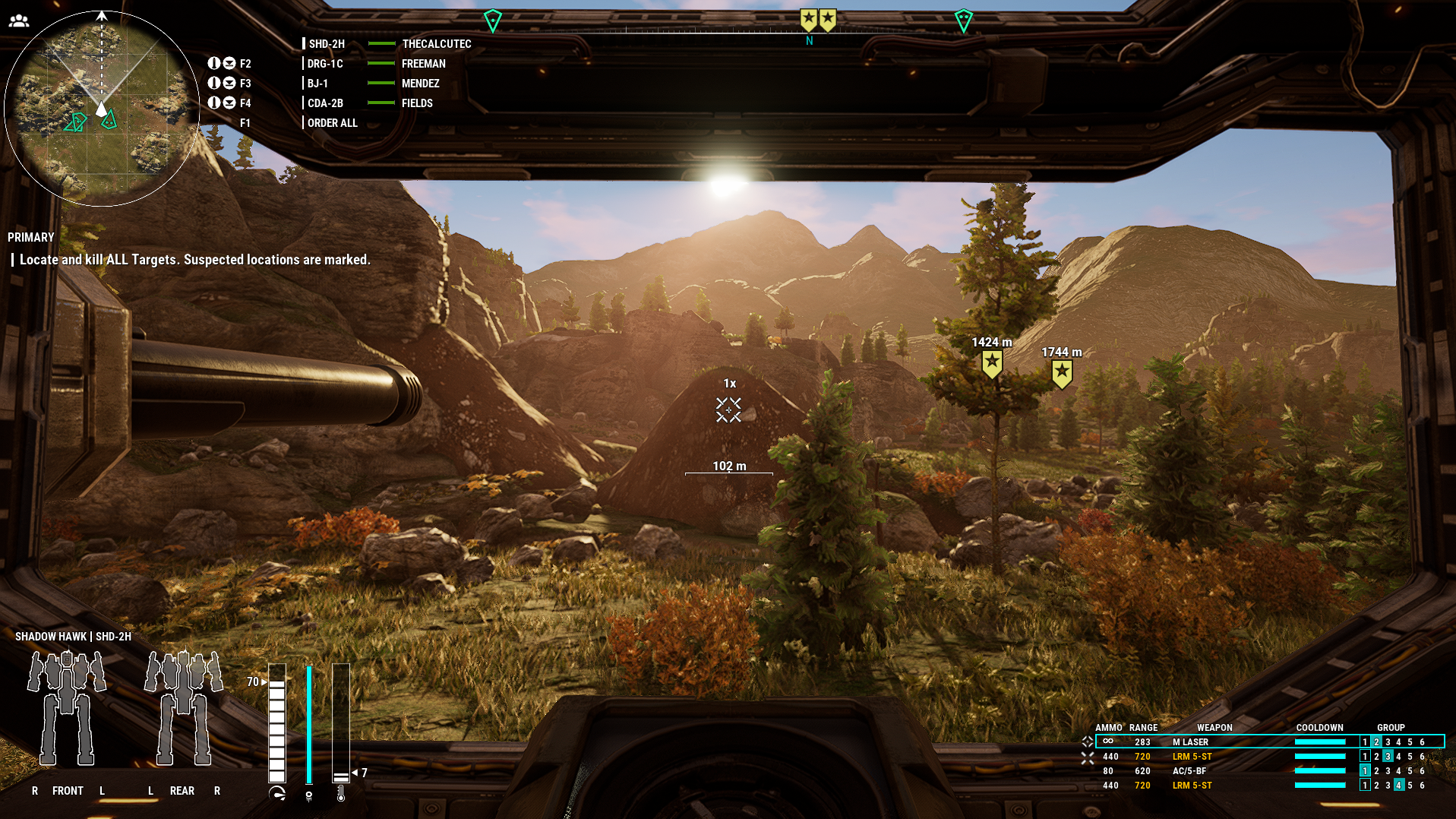
I give this preamble to underscore the high expectations I had coming into MechWarrior 5: Mercenaries. For series fans like me, developer Piranha Games (who also made MechWarrior Online) isn’t just making a new entry in a long-running series, they’re playing with some long dormant hope. With about 25 hours in the game, I can say that Piranha Games has at least awoken that hope, even if it hasn’t quite fully fulfilled it. Sometimes, Mercenaries evokes everything that first brought me to the series. But inconsistency, repetition, and some confused design weigh the game down and make this return a little less glorious than I’d hoped.
From the broadest view, MechWarrior 5: Mercenaries follows the melody played by its predecessors note for note. Cast as a rookie pilot turned vengeful mercenary commander named Mason, you lead your crew of mech pilots from node to node across a vast galaxy map, doing the dirty work of the galaxy’s five major powers (or anyone else who can scrimp together enough cash for your services). As you complete missions—which range from demolition duty to assassination contracts to base defense—you rack up cash, along with gear for your mechs, salvaged robots themselves, and reputation. And as your rep goes up, you eventually unlock new main story missions, which follow your encounters with the nefarious Black Inferno mercenary squad. From a bird’s eye view, so far so good.
Even better, when you zoom all the way in to the way the mechs feel, Mercenaries not only nails everything that I loved about the old MechWarrior games, it actually elevates the action. These mechs move with more heft and force than ever before, and Piranha has emphasized that by focusing on destructible environments, even dedicating two different mission types to destroying buildings. Shredding away a 15th floor corporate helipad from the building its bolted onto with a missile volley is already rad, but slamming an 80 ton mech through some four-story office park only to hear the local corporation-installed mayor shout “Oh no! That’s our Business Center!” is easily one of my favorite gaming moments this year.
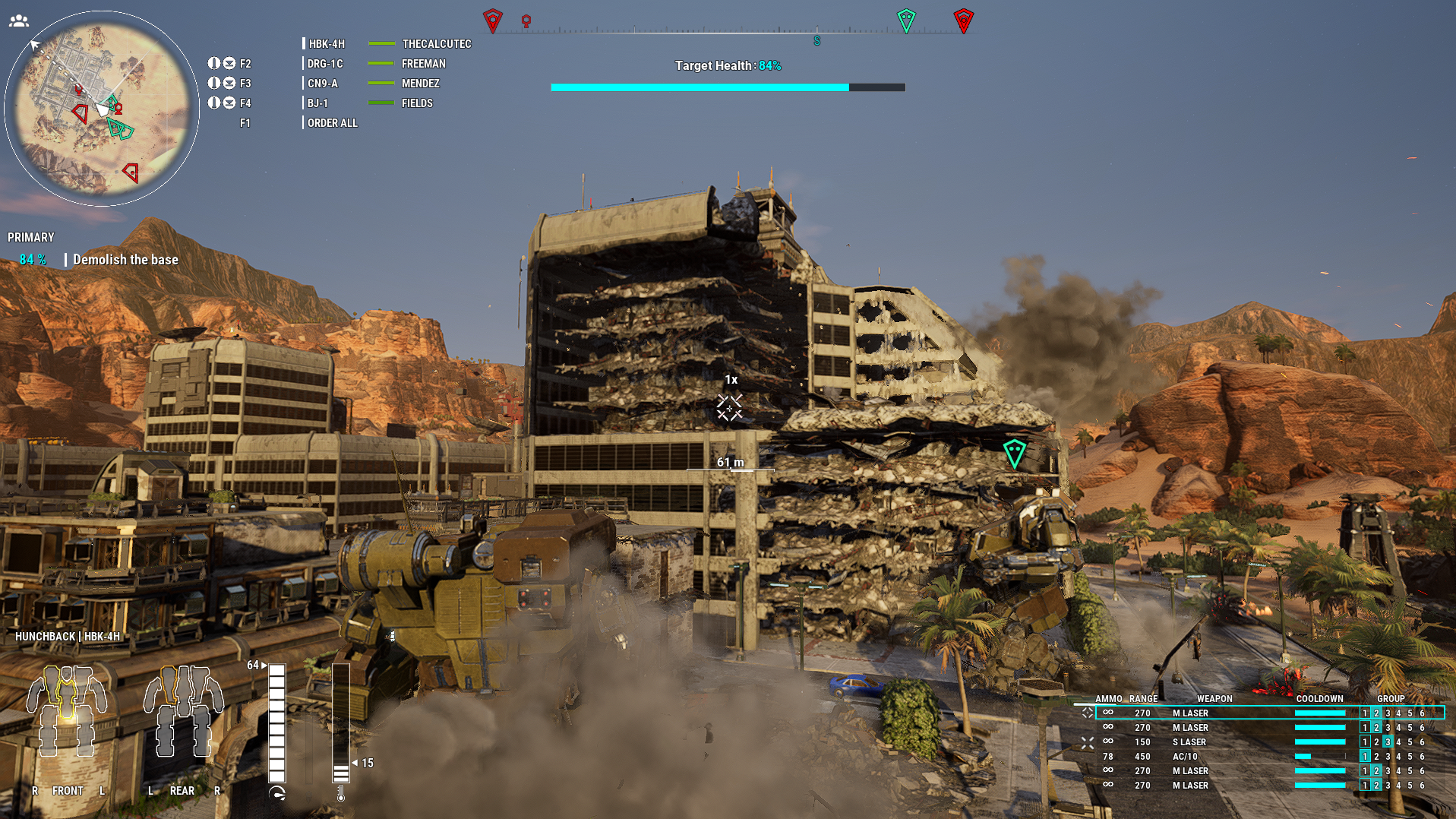
This sense of heightened physicality is also present in just about any individual moment of combat, thanks not only to the aforementioned sense of weight, but also to the audiovisual effects of weapons, and a lot of very visible battle damage on the series’ trademark walking tanks. It was always rewarding to blast an enemy mech’s arm off of its chassis, but now the interaction feels almost analog, less like flipping a binary “arm destroyed” button, and more like shearing metal away. That sense of threat comes your way too: Every incoming missile, laser, and ballistic attack is something you dread, because once your armor is worn away, every new hit could mean the loss of one of your own weapons. And when a mech is finally totaled, it satisfyingly crumples sadly to the ground or (even more satisfyingly) is launched a dozen meters away, propelled by the sheer force of your barrage..
This part of the game is just… listen, it’s just excellent. A mech pokes its chassis over the ridge: What is that? you think to yourself, trying to place its silhouette against the encyclopedia of mechs you’ve slowly been building in the back of your brain for the last 15 hours. When the bright blue of the machine’s particle projector cannon dazzles its way down towards you, slamming into your cockpit, momentarily disrupting your UI, you know instantly: That’s a Panther, a light mech that punches above its weight, but whose power you can negate with just a couple of well placed shots to its right arm. Between the roar of your heavy autocannon, the blackened steel left behind, and the dramatic way your opponent’s metal limb goes flying away in the sky, these moments feel like oppositional, battlefield surgery.
So, again: big picture? Check. Second-to-second action? Got it. To use the parlance of the games themselves, this should be an “all systems nominal” situation. But everything that is supposed to glue these two moments together feels half-baked. And I mean everything.
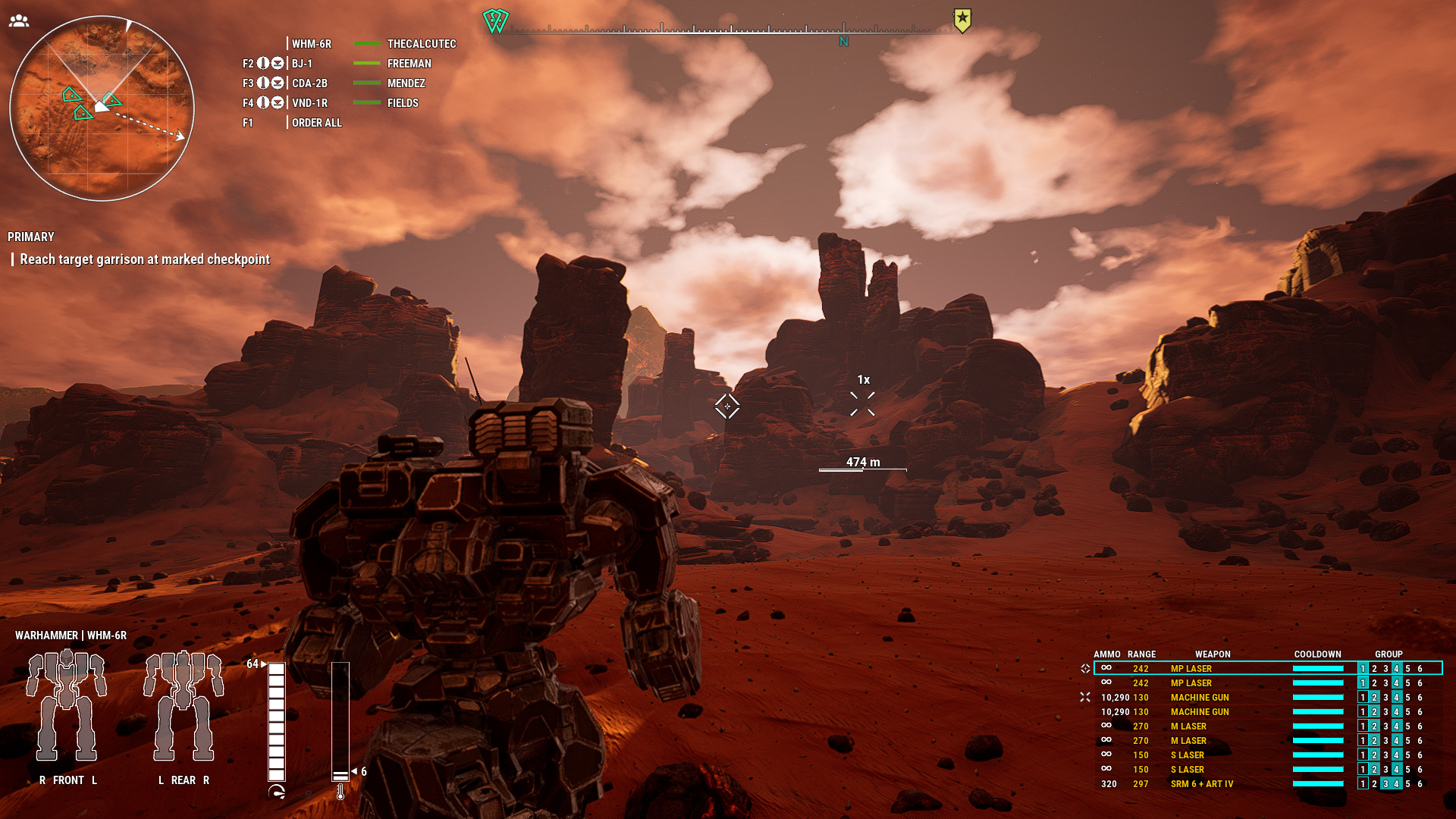
Let’s start with the economy, which is something especially front of mind because of how Harebrained Schemes BattleTech perfectly nailed the grimy give-and-take of mercenary work last year. In BattleTech, even victories were costly, and the “meta-game” in both the story-driven Campaign and management sim Career modes was about balancing your lance’s bank account against your battlefield effectiveness and your crew’s morale. But through the first seven “reputation levels” (about 15 hours of play) in MechWarrior 5: Mercenaries, I never came close to going into the red. Mission rewards always outweighed my monthly costs, and any time I needed a jolt of cash, I could easily flip any extra mechs I had lying around.
Because of this, it wasn’t until 20 hours in that I needed to pay attention to its many dynamic economic systems, which made me feel like that part of the game fundamentally broken.
Early on, Mercenaries introduces you to the idea of galactic “zones.” Conflict zones are the areas of the galaxy map where missions are available, but the tutorial tells you that you should be cautious about repairing your mechs there. Instead, it says, when its time for maintenance, you should head towards industrial zones, star sectors with flourishing markets, cheaper repair prices, better gear available, and which also let you hire new pilots for your crew. But for those first 20 hours, most of the missions have been cakewalks, and I never felt it was too costly or time-intensive to park in a conflict zone and wait out even multiple-month long repairs. (And unlike last year’s BattleTech, there are no random narrative events to spice up this ‘downtime.’ Just a lot of hitting the “Wait” button.
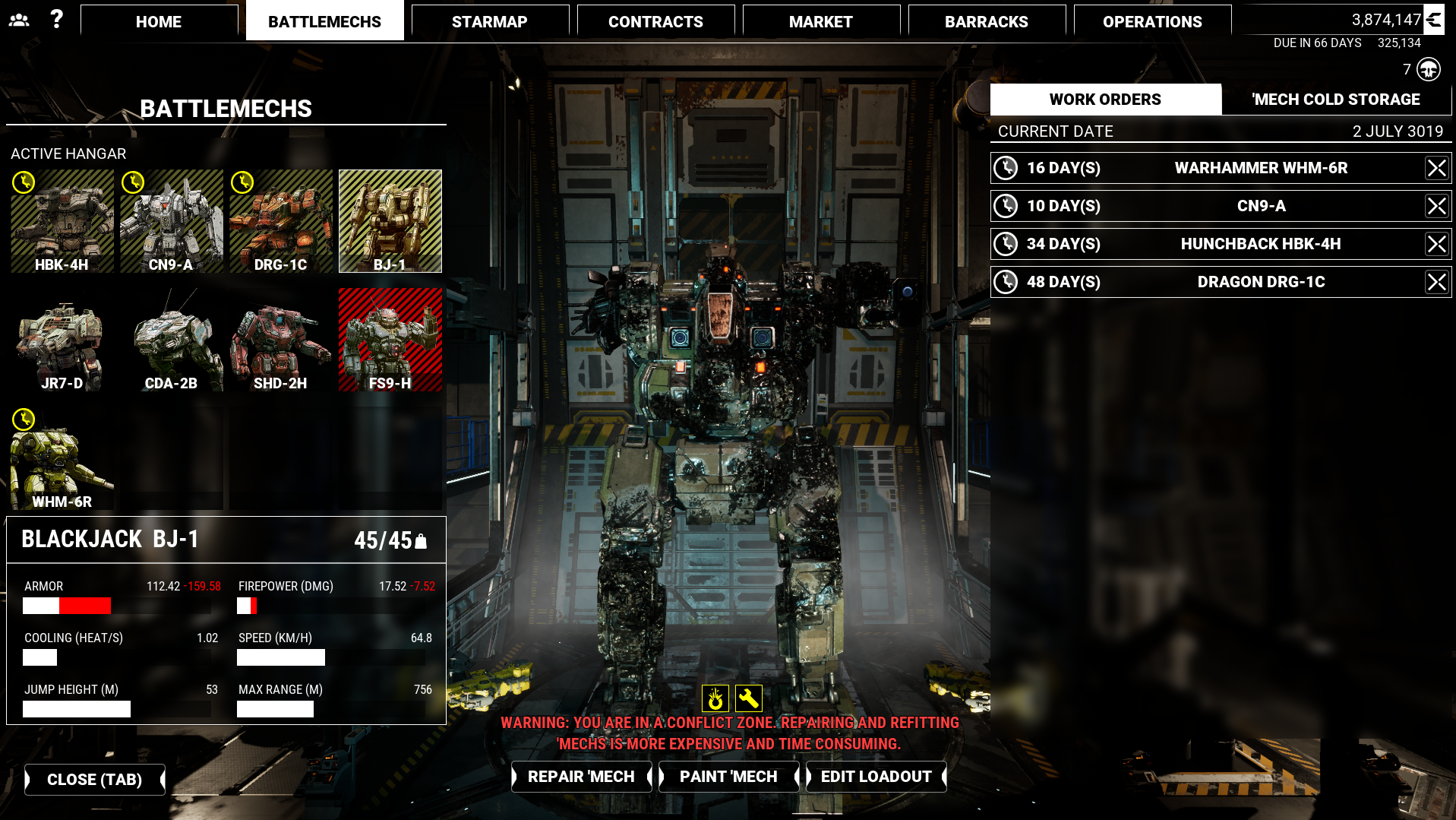
The same could be said for the game’s reputation and “claims” system. As you string together missions for any one faction, you gain reputation with them, which gives you better prices in shops and more “negotiation points” to spend during the contract phase of play. Do you spend those points on bumping up your paycheck, your right to lay claim to scrapped mechs on the battlefield, or on insurance for your own machines? Well, for those first seven reputation levels, money was such a non-issue that this was never an interesting decision to make.
There’s also the fact that the markets seems sort of… broken. Here, take a look at this pair of cropped screenshots from one of the game’s markets:
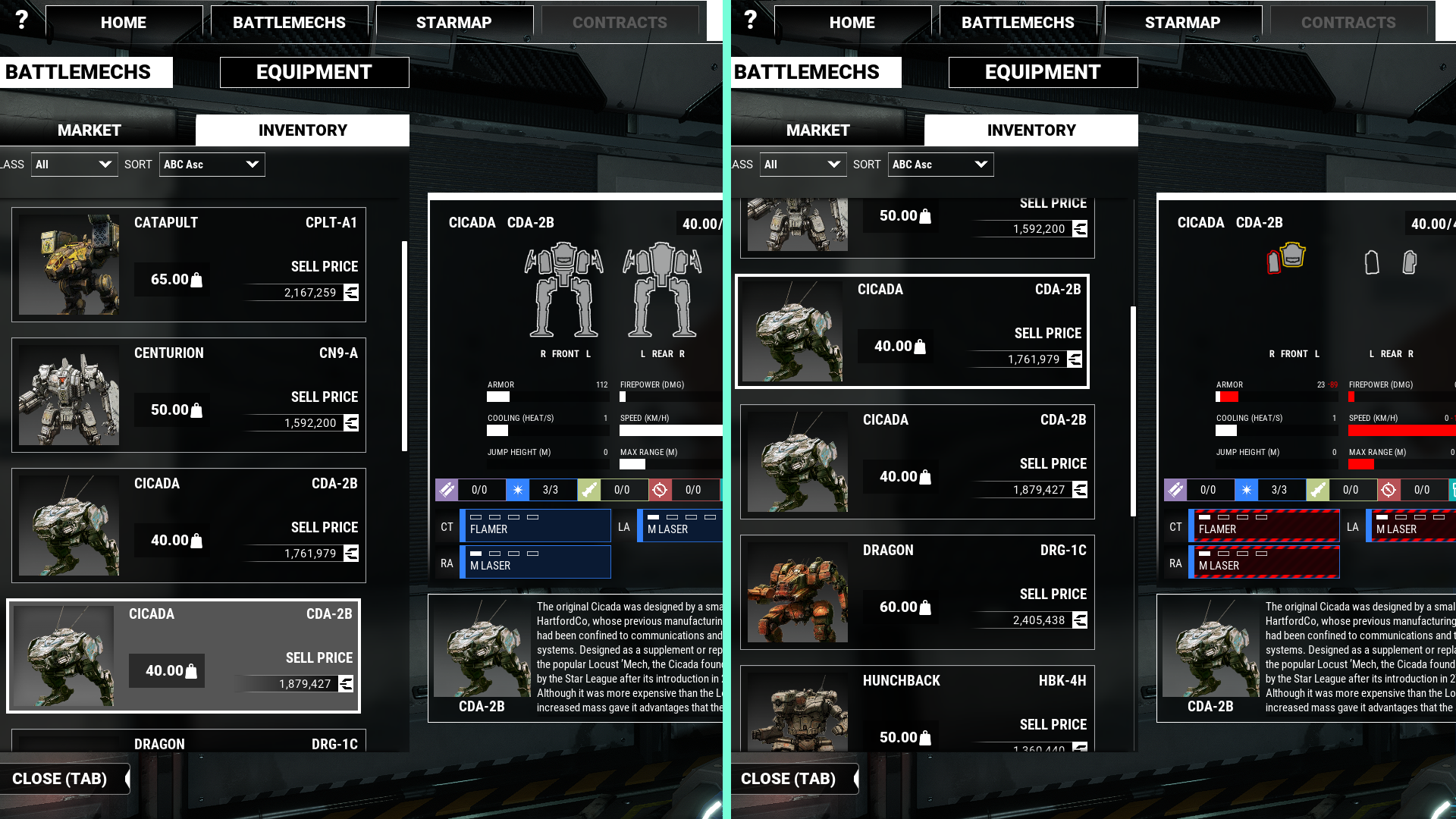
The Cicada on the left, which is in near perfect shape, is selling for 1.87M C-Bills. The one on the right, which has been reduced to a cockpit and one very bruised shoulder, is selling for 1.76M. With prices like these, is it any wonder that I’m constantly flush with cash?
That I even care about this so much speaks to a deeper problem, though. If the missions I played were a blast, I doubt I would even notice the busted economy. Unfortunately, everything to do with these missions except the act of moving these massive mechs around feels inconsistent at best and fundamentally compromised at worst.
There are three broad categories of mission you’ll take while playing Mercenaries. The bulk of your operations will be procedurally generated contracts, which plop you into a random map populated with some landmarks (enemy bases, a farm, an opposition-held city) and give you one of a handful of objectives. I’ll get back to these in a second, but I will take a second to say that one of the rare, positive consistencies is the way these procgen levels look. Snowy mountains, sulfuric deserts, autumnal valleys; each biome provides a distinct sense of atmosphere and placeness, even if the map’s made up of repeated and familiar tile sets.
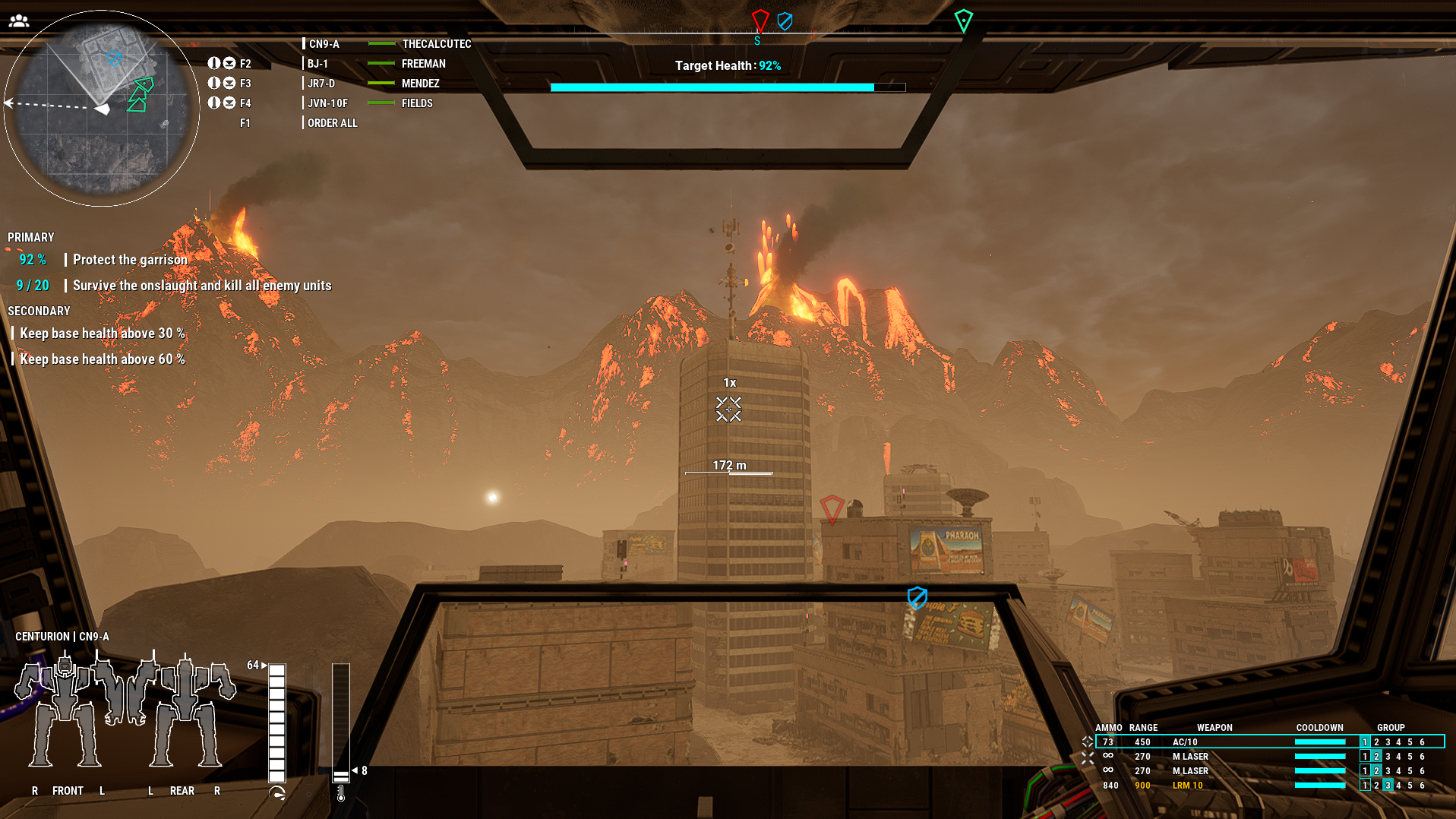
The second, and unfortunately the rarest, jobs you’ll get are the hand authored missions of Mercenaries’ main story. After you finish the opening set, you’ll begin to unlock one of these with every couple of Reputation levels earned from completing the other sorts of missions. While the storytelling and characters are dry and uninspired (especially in contrast to last year’s eminently flavorful BattleTech), these main story quests remain Mercenaries is at its best. The hand-crafted maps and encounters have the rhythm and flow of military sci-fi: Objectives change up mid-mission, opposition reinforcements arrive at the worst possible time, and daring raids lead you heroically up hills and into the (very explosive) heart of your enemy’s base.
The third sort of mission, “High Reward” quests, sits somewhere in between those two extremes. They offer unique setups that draw on the lore of the BattleTech world and tend to come with some unique dialog and maybe a hand picked (though perhaps not specially designed) map. Some of these missions (like one about hunting down a retired group of ace pilots that betrayed one of the game’s major houses nearly a full generation prior) spark the imagination. But in general, they feel too constrained, unable to offer particularly memorable characters, locations, or objectives because they’re made from the same basic building blocks as the procgen missions.
Whether you’re doing one of these High Reward missions or a random contract, your goal will fall into one of five mission types. You’ll either be locating and killing some specific enemy pilots, destroying an entire enemy settlement, surgically eliminating key opposition infrastructure (like comms towers), defending a friendly outpost from incoming enemies, or pushing your luck in a wave based “Warzone” battle that rewards you with better pay the longer you can last.
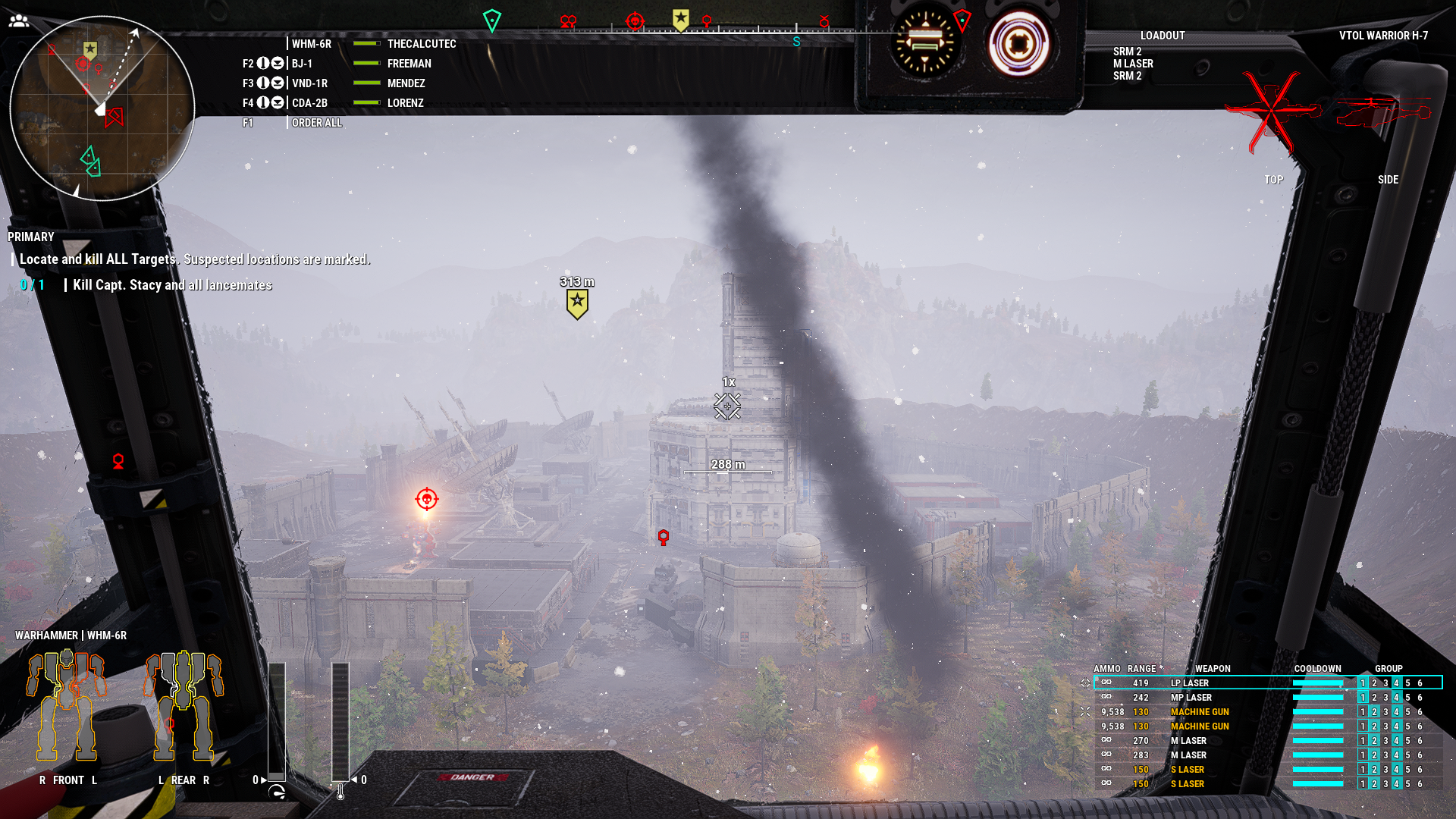
While these objectives felt satisfying at first, the repetition set in sooner than later. It was sometime around my tenth Warzone mission that my interest began to buckle. While Piranha has perfectly nailed the feeling of piloting a mech around, their procgen system rarely gives me exciting things to do in that mech. It’s not only that the authored story missions offer more cinematic pacing and more thoughtfully designed locations for 100 ton firefights. It’s also that these procgen missions proceed in a, frankly, slapdash way.
Let’s say you accept a Warzone mission: Your job is to rush to a House Liao stronghold and defend it from incoming lances from House Marik, one of their rival factions. You deploy, take in the sights (these maps do look beautiful, even on repeated plays), and head towards your waypoint. When you get there, there are a handful of enemy units to clear out, and then the UI tells you that it’s time to clear out another 29 enemies. At which point, those enemies begin to arrive in waves, which immediately makes the game feel more like an arcade-y horde mode and less like the sim I’d hoped.
Sorry, did I say that the enemies “arrive”? I guess that’s true sometimes, when they spawn out of sight and charge over the horizon or arrive via enemy dropship. But other times they just appear as if from nowhere. Just four 50-ton mechs materializing right in front (or, frustratingly right behind) you. If this is a bug, then it’s a pretty severe one, especially given the game’s supposed focus on grounded physicality.
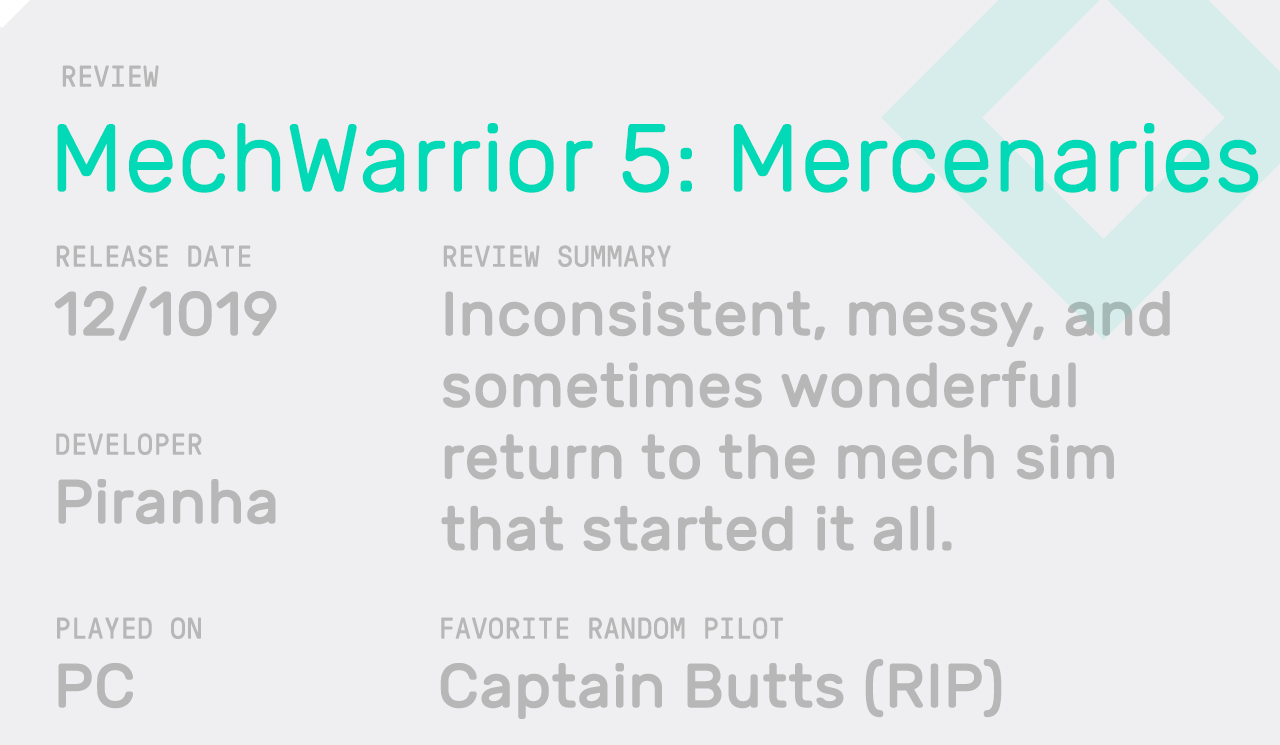
But even if they all showed up in more appropriate ways, the entire idea of making a mission where you fight dozens of enemy BattleMechs feels like it grates against the core appeal of the series. (And that is what you’ll be doing in most of these missions, whether or not they’re reputation rank 3 Warzone contracts or rank 9 story missions.)
What appealed about BattleTech last year, MechWarrior: Mercenaries 2 decades ago, and even Piranha’s own MechWarrior Online more recently is that every fight had the potential to break bad. A well placed AC/20 shot from even the fan-favorite, underdog Urbanmech could ruin your heavy mech’s day. Every encounter was risky. Here, I’m swatting “Urbies” down like flies. When the risk evaporates, the fantasy totally deflates.
After hitting rank 8, (again around the 20 hour mark), the game finally finds a sense of tension. But even the reasons for that difficulty spike are inconsistent. Sometimes, that difficulty comes from being put up against more “skilled” pilots—the game does have a skill rating system for NPCs, and it can be rewarding to see your own lancemates get better over time. But most of the time it feels like Piranha’s idea of “more difficult” is just “more and heavier mechs.” A Warzone mission with 21 enemy units too easy? How about 33?
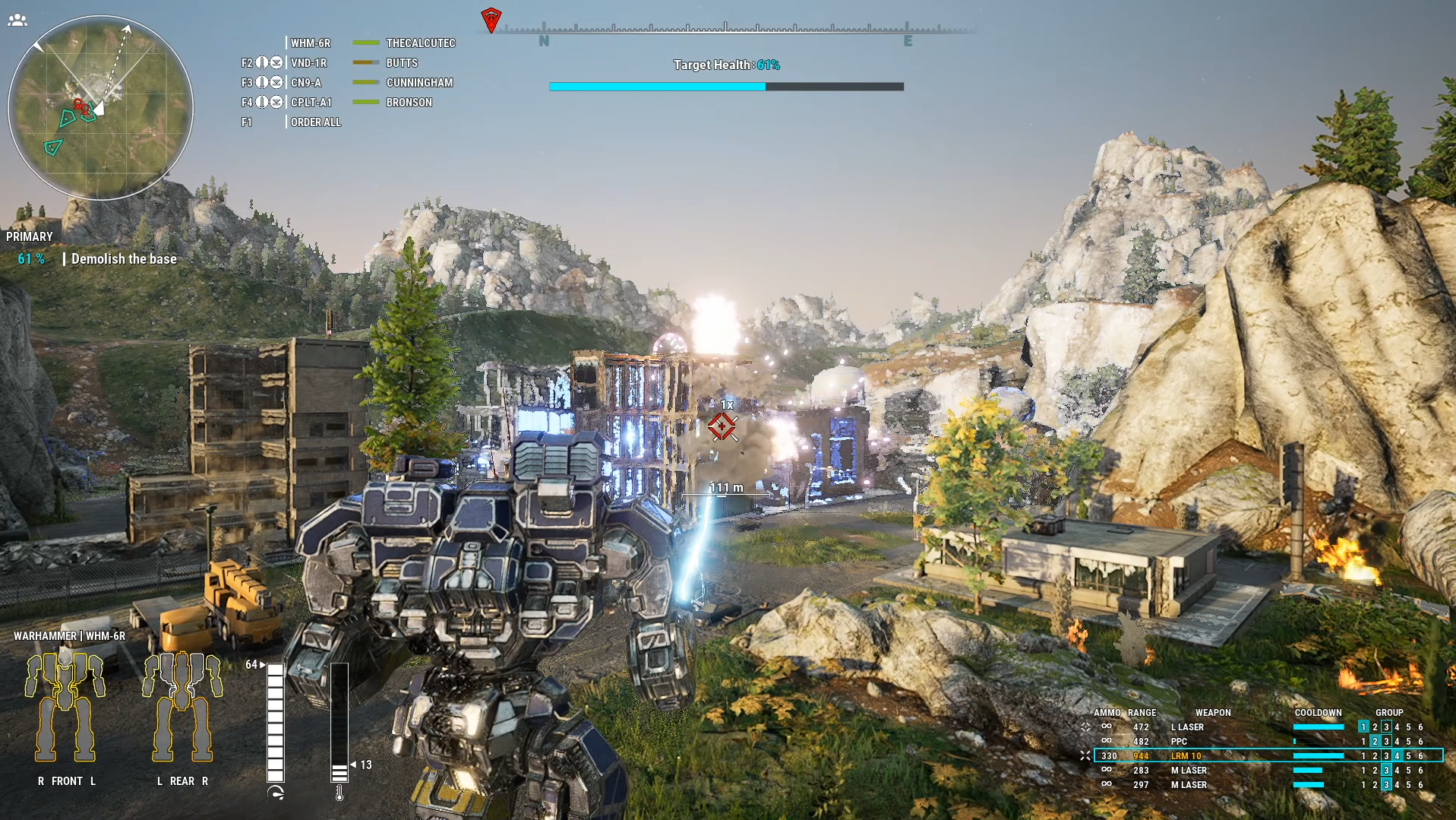
It’s a mess, and I could go on and on critiquing the ups-and-downs of these and other elements of the game. The game’s cast of heroes and villains is as interesting as drywall, but the mechs themselves, which tower over you as you walk through your hanger, offering more than enough character on their own. The procgen maps can be infuriating, offering impossible odds on bland territory, or captivating, offering you skirmishes as memorable as any AAA action game setpiece. Even the series’ trademark mech customization is a mixed bag, offering some better guidance for new players while severely limiting the customization potential for veterans comfortable with the system.
It all leaves me at a bit of an impasse, with feelings as messy as the game itself. In fact, last night, after I’d filed this review for editing, I hit a three hour string of regular missions so sharp and enjoyable that I rushed to edit this review. “It just takes a while to get good!” I noted, with relief and elation. Then, another rough patch of boring missions and frustrating bugs, and finally a crash to desktop. It’s not bad, but inconsistency reigns supreme.
It’s hard to deny that Mercenaries offers flashes of that old joy. Even as I complain about the lack of mission variety, the particulars can still evoke magical scenes: The brilliance of landing a PPC shot and seeing the entire top-half of an enemy tank flip up and away. A VTOL gunship lifting up among autumnal trees, rising to fire its cannons at me and my lance. The flight-or-flight moment of seeing the distinctive silhouette of an enemy Catapult on a hill, knowing that my best option is to run towards its endless volley of missiles so that I can get inside of its effective range. Even my losses can give me stories to tell, when things work right: Never doubt the ability of a light mech to tear your heavy to shreds once it gets you trapped in the urban canyons of a dense city.
In these snapshots, MechWarrior 5: Mercenaries is exactly what I wanted. So much so that even now, in writing those words, I’m eager to boot the game up and dive back in, powered by my love of the franchise and a whole ream of “maybes.” Maybe if I finally find manage to find a co-op partner (there’s no matchmaking that I can see), things will start to feel more tactical. Maybe reputation rank 10 or 11 or 12 is where the game really starts to shine. Maybe they’ll do a balance patch that fixes my issues—after all, the core skeleton of the game works, and a day zero patch did make some key improvements. But at $49.99, that many maybes makes it a hard game to recommend to anyone who isn’t already versed in the mythos and majesty of BattleMechs.
Yet for me, who has been waiting for this game for 17 years, who first fell for the franchise when I was 11 or 12? It’s like I said up top: That long dormant hope has been awoken. The scaffolding is here for something not okay, but fantastic. In the era of games-as-service—and with Piranha’s own history supporting a multiplayer game clear in my mind—it’s easy to imagine Mercenaries not as a misfire, but as an opening salvo of something greater to come.
This article originally appeared on VICE US.